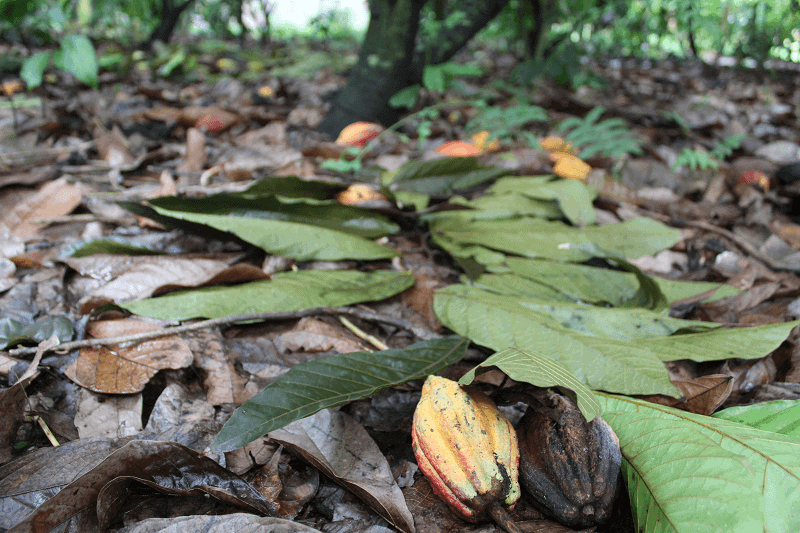Lately there’s been renewed concerns over the heavy metal content in chocolate. This is all thanks to an article released by a California-based organization, Consumer Reports, and a lawsuit filed in New York state.
Consumer Reports’ article is based on research initiated years ago by non-profit As You Sow, and their subsequent lawsuits against big chocolate companies. The basis for the suits is their failure to inform consumers of the heavy metals in their chocolate products, particularly cadmium (Cd) and lead (Pb).
Although the levels of cadmium in chocolate have been taking the spotlight, lead exposure and its dangers are just as prevalent. The issue is that media coverage is good at presenting how destructive lead toxicity can be, but fails to expound on how much danger the chocolate actually presents.
This article will focus on some of the history of lead exposure, potential dangers, what regulators say (for context), and how it may find its way into chocolate.
What will become apparent is that the dangers of lead toxicity do warrant caution, but also that exposure has been declining progressively. There are simple things you can do to significantly reduce lead absorption in your body; just the same, any effort to reduce lead exposure from chocolate is welcome.

Jump To
Sources of Lead in Chocolate
Lead (Pb) is a versatile metal that’s been utilized by human civilization for its properties since ancient times. The oldest known man-made object that contained lead is a small statue found in Turkey, dating back to 6,500 B.C.
It’s abundant on the earth’s crust and spread thanks to natural causes like volcanic and human activity. In a 1980 report, the United States was said to produce and use 1.3 million tons of lead per year, which was 40% of the global supply at the time.
Most of that was used as an additive in gasoline, pigments for house paint, and small amounts in solder used to join pipes in plumbing. Despite the considerable reduction in global lead usage since then, these old sources contribute to most of the lead exposure in American children.
Lead contamination in cacao is not new, and is a problem recognized since 1820, when Friedrich Accum’s investigation identified it in confectionary products. In a 2005 study of lead contamination in cocoa, they concluded that the cacao bean’s shell absorbs a lot of lead.
It was noted that the initial lead contamination levels reported in cacao nibs were among the lowest in natural food. However, finished cacao products consistently showed higher lead concentrations— up to 300-fold, a claim in Consumer Reports’ article restates.
This indicates that contamination could be happening during transport, storage, processing, and manufacturing rather than from the raw materials. A potentially important source of contamination was tetra-ethyl lead (TEL), an additive in gasoline.
In gas it functioned as an octane booster to improve engine performance and reduce engine-knock in vehicles. The use of TEL has been progressively phased out in the US, but some countries continue to use it. 90% of lead pollution in Nigeria, for example, is derived from combustion of leaded gasoline which contaminates dust, plants, foods, and people.
Historically lead was also added to pesticides, fertilizers, paint, and machinery, each of which might have contributed to the initial lead contamination in cacao beans. Another source is cited by a 2019 study on the mobility and transport of lead in soil used for agriculture.
Data gathered from open & closed canopy cocoa fields in Ghana showed that urban and peri-urban farming systems contributed to lead contamination. It turned out to be because they used contaminated sewage sludge and waste-water as cheap fertilizer and irrigation for their agricultural soil and groundwater systems.

Risks of Lead in Chocolate
A wide variety of illnesses are associated with lead exposure, ranging from renal, gastrointestinal, cardiovascular, hematological, reproductive, and neurological systems, to adverse developmental effects, low bone mineral density, and cancer. Blood Lead Levels (BLLs) are used as a risk measurement for the various illnesses.
California Office of Environmental Health Hazard Assessment (OEHHA) notes that the negative effects of lead exposure are magnified in children due to the concentrations of lead in their small bodies compared to an adult’s. In a 2015 review, BLLs of 10 µg/dL or greater are a cause for concern.
The threshold for children was 5 µg/dL and was adjusted by the CDC to 3.5 µg/dL in 2012 with the introduction of the blood lead reference value (BLRV). This metric serves as an advisory level for environmental and educational intervention rather than a strict mandate for states to act on. In fact, it isn’t uniformly implemented across states.
Chronic exposure to lead, like in industrial workspaces, can lead to cardiovascular and fertility problems. Maternal lead exposure can lead to increased risk of spontaneous abortion, premature births, low birth weights, congenital abnormalities, post-birth effects of growth or neurological development, and learning disabilities.
However, the greater concern is given to the neurological and behavioral changes that may occur due to accumulated lead exposure in children. This is what’s gotten people so worried about heavy metals in chocolate; it’s more difficult to detect long-term exposure, and the effects are magnified.
Lead has also been classified by the US Environmental Protection Agency (EPA) as a probable human carcinogen. Other health risks include abdominal pain or lead colic, anemia, decreased cell development, dental manifestation in the gums, problems in the kidneys, and low bone mineral density.
For more details, please see official CDC guidelines.

How to Reduce Lead Exposure from Chocolate
One way to reduce lead exposure from chocolate is to be informed and avoid products that contain a lot of it. However, chocolate makers usually focus their marketing on allergens and the environmental and social impacts of their business models.
Even among regulations related to chocolate, the levels of cadmium exposure are more defined than those for lead. Look at the FAQ section of chocolate makers in search for publications and certificates of analysis (COA).
Some examples are Raaka Chocolate’s Heavy Metal Test Results, possibly Theo Chocolates, possibly Askinosie Chocolates, and Navitas Organics Chocolates. By extension, it’s also possible to reduce lead exposure from chocolate by carefully selecting the origin and type of cacao the chocolates are made from.
In a 2019 study, they found that among the global cocoa production, beans from Latin America had higher levels of heavy metals, especially cadmium and lead. Another 2017 study on the accumulation of heavy metals in Peruvian cacao found that the levels varied between genotypes, where native cacao varietals were lower.
Lead exposure is usually addressed by legislation, like the European Union’s Commission Regulation (EC) No. 2021/1317, which focuses on establishing maximum levels of lead in foodstuffs. However, the technical report on cacao by the European Food Safety Authority (EFSA) defined the limits of cadmium in cacao, but not lead.

In the US, the Food and Drug Administration (FDA) and the Center for Disease Control (CDC) are the main agencies setting lead intake limits. For reference, the OEHHA FAQ defines “Safe Harbor Numbers” that attempt to define safe exposure to hazardous materials. Part of how they calculate this is a “No Observable Effect Level (NOEL)” designation.
This is a number based on the highest exposure level considered harmless, divided by 1000. Using the NOEL, they calculate the maximum allowable dose level (MADL). Prop 65 has an MADL of 0.5 µg/day for lead and a threshold for oral lead intake that poses a cancer risk at 15 µg/day.
As You Sow’s research model uses the Prop 65 MADL of 0.5 µg/day as their own. For greater insight into OEHHA’s child-specific lead exposure risk assessment, check out this 2007 OEHHA’s report.
When it comes to absorption into the blood, the US National Library of Medicine already recognizes that although lead was the metal with the highest concentrations found in soil it was also the least absorbed by the body.
A 2011 review of oral bioavailability of lead and arsenic in contaminated soils showed that soils treated with phosphate and compost could result in lower absorption. It turns out that the level of lead absorbed from diet/water/soil is closer to 5-10% of the total lead value, compared to 60%, as was previously thought.

The Agency for Toxic Substances and Disease Registry (ATSDR) 2010 sets theirs to a minimum of 20% in adults and 50% in children. The actual absorption rate of lead can go up and down based on whether or not you’ve had a meal or not beforehand.
Absorption rates are higher on an empty stomach, and when you have mineral deficiencies such as a lack in zinc, iron, calcium, magnesium, and vitamin C. 94% of the total body burden of lead will find its way into teeth and bones, while the amount is 73% in children (Barry 1975, Cited by ATSDR 2010).
So making sure your body is getting the right amount of nutrients from meals, and not eating chocolate on an empty stomach can reduce lead absorption by as much as 90%.
Higher heavy metal content in chocolate is due to the presence of nonfat cocoa solids, so another way to reduce lead exposure from chocolate is to enjoy milk chocolate or white chocolate. Although there were low lead dark chocolate products among those tested, milk and white chocolates consistently tested lower.
Finally, makers can reduce lead contamination in chocolate by keeping a close eye on their cacao during key processes. A 2017 research article on heavy metal levels in raw and processed cacao identified the winnowing of cocoa shells and conching as steps where lead concentrations could be significantly reduced.
This coincides with As You Sow’s recommendations of preventing nibs from mingling with cacao shells after being separated.

Chocolate Brands High in Lead
Due to the toxic effects of lead during children’s developmental stages, defining what constitutes a level for concern can be difficult. Despite the illnesses associated with lead exposure, clarity is needed on how much chocolate may actually contribute to lead toxicity.
To further build upon regulatory guidelines, consider that Prop 65 has a MADL threshold of 0.5 µg/day. The FDA’s 2022 updated guidance on action levels are 2.2 µg/day for children and 8.8 µg/day for females of childbearing age.
The UK’s Committee on Toxicity (COT) uses a model where a consumption of 0.5 µg/kg body weight per day by a child of 20 kg (44 lbs) or 10 µg/day resulted in a drop in IQ by 1, and that children absorb an average of 42% of lead they eat.
With this in mind, below is a list of notable chocolate products with higher and lower levels of lead, according to As You Sow’s investigation. Just keep in mind that a ‘serving’ varies widely.
Chocolates High in Lead (Pb)
- NOW Healthy Foods Certified Organic Cocoa Powder Pure @ 7.2 µg per serving
- Theo Organic Fair Trade Coconut 70 Dark Chocolate @ 3.7 µg per serving
- Valrhona Poudre de Cacao Cocoa Powder 100 Cacao @ 3.0 - 3.6 µg per serving
- Endangered Species Chocolate Natural Dark 88 Cocoa @ 3.4 µg per serving
- Taza Chocolate Mexicano Super Dark Stone Ground 85 Organic @ 3.0 µg per serving
- Lindt Excellence 86 Cocoa Extra Dark Chocolate Bar @ 2.8 µg per serving
- TCHO Dark Chocolate Ghana 70 Cacao @ 2.7 µg per serving
- Trader Joe’s Pound Plus Dark Chocolate @ 1.6 µg per serving
Chocolates Low in Lead (Pb)
- Theo Chocolate Organic Extra Dark Pure Dark 85 Chocolate @ 0.5 µg per serving
- Hershey’s Cocoa 100 Cacao Natural Unsweetened (2022) @ 0.5 µg per serving
- Navitas Organics Cacao Nibs @ 0.1 µg per serving
- Taza Chocolate Wicked Dark with Toasted Coconut 95 Dark @ 0.1 µg per serving
- Ghirardelli Chocolate Intense Dark Midnight Reverie 86 Cacao @ 0.1 µg per serving
The amount of lead tested in the same chocolate products tended to return varying results. This was even true for chocolates tested in the same year. Chocolates tested more recently tend to show considerable reductions in their lead levels, but not all.
Milk chocolate consistently tested for lower lead levels, but many dark chocolates were also found to be low in lead, even by Prop 65 standards. The dangers of lead toxicity through chocolate are less dire than the media makes it seem.
Remembering to eat chocolate mainly after meals and consuming a diet high in minerals significantly reduces lead absorption. As You Sow’s efforts are not without their benefits, however, hopefully the attention they’ve drawn will help the industry overall lower lead levels in chocolate.

Lead and Chocolate FAQ
Lead is distributed in the environment through both natural means and human activity. Cacao shells accumulate lead from the surrounding soil, for example. However, research shows that lead concentration levels are considerably greater in finished cacao and chocolate products, implying that contamination occurs in transit or processing, after the beans have left the farms.
Studies show that lead in chocolate is found in the cocoa solids. Chocolates that contain lower cacao levels, like milk and white chocolates, consistently have lower lead levels. Mixed and filled chocolates have even lower lead levels, as they have less cacao solids. However, preventing exposure post-harvest will allow chocolate makers to produce darker chocolate with even lower lead levels.
Processed cocoa powder and dark chocolate tend to have more lead. However, even though they are more likely to have higher lead levels than milk, white, or mixed chocolate, it is possible to find dark chocolates with low lead levels if makers keep track of and address sources of post-harvest contamination.
Organic chocolate can contain lead. Lead is a naturally occurring metal in the environment and is very difficult to eliminate completely. Lead isn’t absorbed by cacao nibs as well as cadmium is, but instead is absorbed by the shells. Newly harvested cacao tend to have very low lead levels, one of the lowest among all tested foods. Tracking cacao and preventing lead build-up after harvest is key to keeping levels low, though attention to lead exposure varies by manufacturer.

















Bob
Lead in Chocolate!!! That is so interesting
Max
It was fascinating to research - you really don't know what goes into or onto your food, sometimes!